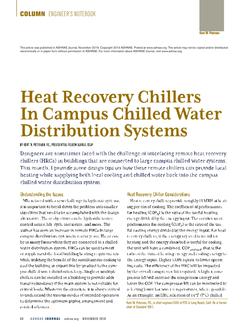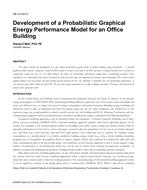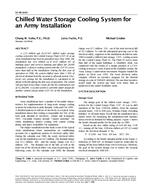The ASHRAE Standard 55-1981 specifies temperature limits or zones for winter and summer comfort. It states that the upper limit of the summer comfort zone, which is 79°F (26°C), can be extended to 82°F (28°C) with air velocities of 160 fpm (0.8 m/s). The manufacturers of ceiling fans claim comfort may be obtained at velocities considerably below the 160 fpm (0.8 m/s) level. They further claim that 82°F (28°C) with a ceiling fan will provide the same amount of comfort as 75°F (24°C) without a fan. Since ceiling fans require less than a penny per hour to operate, their use, as opposed to air conditioning, could represent a large energy savings without affecting human comfort.
To examine these claims, 256 human subjects were exposed to 76°F, 79°F, 82°F, and 85°F (24°C, 26°C, 28°C, and 29°C) at 50% rh. During the first hour of the three-hour exposure, no fan was used; this "still air" velocity constituted the control velocity, V0, 10 fpm (0.06 m/s). Following this, a ceiling fan was turned on. During the next four half-hour periods, the subject experienced four different air velocities by moving to different locations in the room. These velocities were: V1 (30 fpm or 0.15 m/s), V2 (50 fpm or 0.25 m/s), V3 (90 fpm or 0.46 m/s), and V4 (200 fpm or 1.02 m/s2).These, together with the "no-fan" or control condition, represented five velocity parameters.
Four subjective measurements were (1) thermal sensation, (2) thermal comfort, (3) temperature preference, and (4) air plume quality.
The velocity/temperature trade-off is estimated as 25 fpm/°F (0.22 m/s/°C). The temperature/ velocity trade-off thus is 0.04°F/fpm (4.5°C/1 m/s).
For a representative velocity of 140 fpm (0.7 m/s), this was equivalent to lowering the ambient temperature by (140 fpm) x (.04°F/fpm) = 5.6°F (3.1°C). The National Bureau of Standards suggests a reduction in air conditioning demand of 3%/°F (5.4%/°C). Thus the energy saving provided by 140 fpm (0.7 m/s) from a ceiling fan would be 5.6°F x 3%/°F = 17%. Thus it was concluded that a ceiling fan may extend the upper limit of the summer comfort envelope from 79°F (26°C) to 85°F (29°C) (the equivalent temperature on any specific situation depends on the velocity of the air on the person). The results suggest that the turbulent and variable characteristics of the air plume of the ceiling fan may be its major comfort-producing feature.
Citation: ASHRAE Transactions, 1983, vol. 89, pt. 1A, Atlantic City, NJ
Product Details
- Published:
- 1983
- Number of Pages:
- 19
- File Size:
- 1 file , 1.8 MB
- Product Code(s):
- D-AC-2752


